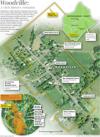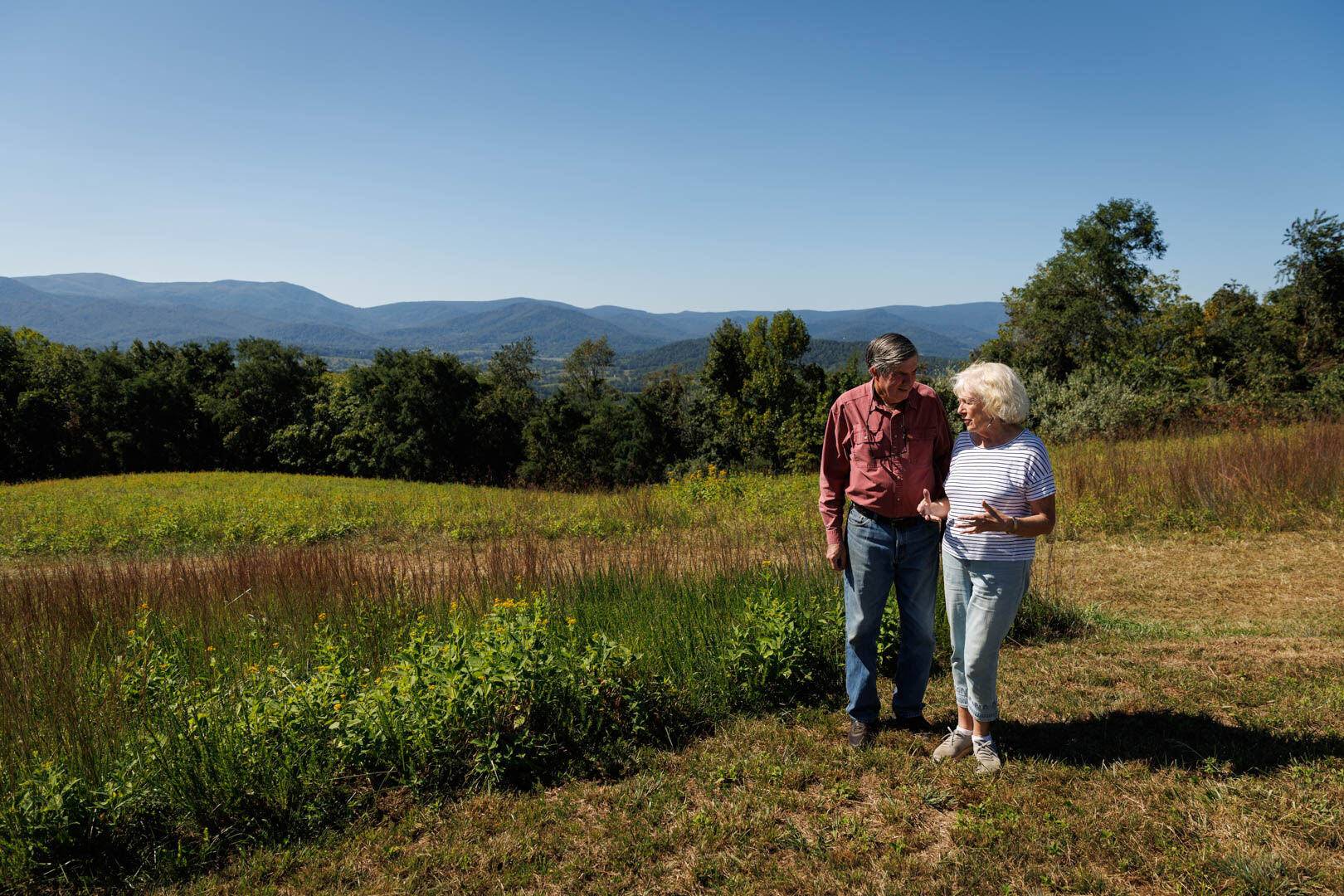Woodville, a blink of a hamlet that’s a 60-second drive-through between Sperryville and Culpeper on U.S. Route 522, may be the smallest village in Rappahannock County, but it has a rich, colorful history and now, evolving possibilities for its future.
Woodville’s story is replicated in small towns across the Virginia Piedmont — prosperous growth in the 19th century followed by decades of decline in commerce and population And now, the beginnings of a new chapter for Woodville are tied to the slowly emerging fate of the sprawling Eldon Farms.

2023-09-18-FF-Woodville–1-web-2.jpg
Shiloh Baptist Church seen from about one quarter up Red Oak Mountain. It was the only church not severely damaged by the 1929 tornado.
At 7100 acres, the property is one of the East Coast’s biggest, undivided landholdings. Making up about half of Woodville’s 22749 zip code, it stretches along the southwest side of Woodville, south toward Slate Mills and west to Sperryville.
“We recognize Eldon has an important influence on Woodville,” said Chuck Akre, who purchased the farm in 2021 and also is developing the first mixed-use development in Little Washington where he lives. “We don’t have anything planned for the property, and should its use ever change to something other than cattle pasture, it would have to be completely compatible with the community.”
Akre has engaged a landscape architecture firm, Nelson Byrd Woltz, in Charlottesville, to develop a “massive” long range plan for the property. Addressing conservation, community accessibility, nature trails, agriculture and a viable cattle operation, it is expected to be completed next year.
Woodville’s past
The origins of Woodville date to land grants issued by Lord Fairfax in the mid-1700s. In 1833, it was in the running for Rappahannock’s county seat. During the Civil War, thousands of Confederate and Union troops regularly occupied its fields and homes. In 1929 it was nearly destroyed by a powerful tornado. On nearby Red Oak Mountain, orchards produced some of the finest apples in the county. Today, Woodville is one of six villages identified in the county’s Comprehensive Plan.

Woodville.v7.pdf
Local historian Misty Hitt Wright, whose family ties to the village date back to the 1840s, said: “Key events like the Civil War, population shifts to the cities in the early 1900s, the tornado in 1929, the decline of farming, and the creation of Eldon Farms in the 1960s all brought changes to the village.”
Once a bustling community of shops, tradesmen, taverns, doctors, four churches and even a hotel, Woodville today is a quiet village. Residents, many whose families have lived there for generations, treasure its history and sense of community.
A small cluster of homes and just three lots zoned for commercial activity are the “core” of the village. Other than Burke’s Antiques and Consignments, formerly Burke’s Store, there are no retail businesses. The village’s last outlet, Mary’s Little Shop, closed in 2010.
After 195 years, the village post office closed in 1998. But its sprawling zip code remains, stretching from Scrabble to Sperryville and from Rock Mills to F. T. Valley Road.
It could have been the county seat
Following a local petition, Woodville was established in 1798 by an act of the Virginia General Assembly, two years after “Little” Washington. The town was laid off on half-acre lots, with streets named for trees like Poplar, Walnut and Maple. Although most have since disappeared, Cherry Street, once the town’s main street, now is part of U.S. Route 522.
There is some debate over how Woodville got its name. Some say it was for the surrounding forests. Others believe it was named for Rev. John Woodville, the rector of St. Mark’s parish in Culpeper, who often visited the village.
When Rappahannock County split from Culpeper County in 1833, county leaders had to decide where to locate the county courthouse. By then, both Woodville and Washington were thriving communities and each vied to be the county seat. Some in Woodville opposed the move, including Captain William Walden, an influential landowner. He and others were said to worry that drunken and rowdy behavior on court days would corrupt the town.
In the end, Washington was chosen, likely because it was more centrally located.
A Civil War thoroughfare
“I am now camped in a beautiful rolling, hilly mountainous country. Large farms, mostly of clover and timothy, cattle being the chief business… All the [white] people are hot secessionists. … All the young men are in the rebel army…”
— Gen. Robert H. Milroy to Mary Milroy, July 14, 1862
Woodville expanded as an economic center with the approval, in 1848, of the New Market to Sperryville turnpike, connecting the village to Culpeper to make it an important thoroughfare in the coming Civil War.
Sign up for Rapp News Daily, a free newsletter delivered to your email inbox every morning.
Its hard surface was perfect for moving both Confederate and Union troops and artillery to battles in the Shenandoah Valley and north, to places like Antietam and Gettysburg.
“Woodville was the site of a lot of activity during the Civil War,” said John Tole, president of the Rappahannock Historical Society. “No battles were fought, but you had thousands of soldiers on both sides marching through or camping there, using the same sites multiple times throughout the war.”
A Union brigade of 5,000 men commanded by Gen. Robert H. Milroy camped around Woodville in the summer of 1862. Milroy, a fervent Unionist who made his headquarters at the Clover Hill estate, now part of Eldon Farms, rounded up over 100 locals and forced them to pledge allegiance to the United States.

2023-09-15-FF-Woodville–6-web.jpg
The northbound entrance to Woodville.
Milroy and fellow Union General Franz Sigel, who commanded 8,000 troops camped at Sperryville, trained in a mock battle in July 1862 near the intersection of U.S. Route 522 and Yancy Road. According to Tole, it was the largest military action in the county during the Civil War.
A year later, at the Second Battle of Winchester, Milroy was defeated by Confederate General Richard Ewell. Ironically, Ewell marched through Woodville on his way to the battle.
Generations on Red Oak
Known for its spectacular views, fertile fields, and once abundant apple orchards, Red Oak Mountain always has been considered integral to Woodville — and a draw for the rest of the county.
The Johnson family reportedly was first to settle “the Red Oak,” in the mid-1700s. The original cabin still stands and is owned by the family of Henry B. Wood III, a direct descendant of William Johnson who had purchased most of the mountain in 1764.
“I go back probably nine or 10 generations in the Johnson family line,” said Wood. “A lot of the old families around here have a genealogical connection to that family.”
Two of those connections, Kathy Grove and Tom Johnson had deep family ties in the area, but grew up away from Woodville — Kathy in Arlington, Va., and Tom in Lakeland, Fla. As youngsters, both made family visits during the summer.
“Woodville was my summer camp,” said Grove. “As a little girl I loved spending time up on the Red Oak, visiting my great uncle Raymond Johnson, great aunt Juluette and great-grandmother, Florence Johnson. When I was older, I’d drive out for the day with friends to show them around the mountain with its fabulous views and visit the old family cemetery up there where many of my relatives are buried.”
Over the years, Grove maintained her strong connection to the community and in 2004 permanently moved near the village, into a 1750s farmhouse, which she and her husband, Larry, renovated.
Tom Johnson now lives in his grandparents’ home, where he too spent summers in his youth. “I liked the country life,” he said. “I’d help around the house, feed the chickens and cows, weed the vegetable garden and go for long walks up the Red Oak to visit my uncle Raymond who lived in the house at the top. The Red Oak really reminds me of that 1970s TV show, ‘The Waltons.’ Back in the old days, it was mostly all Johnsons who lived on the mountain.”

2023-09-15-FF-Woodville–2-web.jpg
Cousins Tommy Johnson and Kathy Grove atop of Red Oak Mountain
After his uncle passed away, the family house was owned for 50 years by someone outside the county who rarely used it. “I ended up living there as a tenant when I moved here in 1994, and a couple of years ago, I had the opportunity to buy it. It’s nice to have the old homestead back in the family,” said Johnson.
Not every family who lived on the Red Oak were Johnsons.
William Jones Jr.’s great-great grandfather, James Foley Jones bought a 90-acre farm on the mountain in 1882. Jones Jr., a former automobile industry executive and retired president of a nonprofit organization in Michigan, bought the property from relatives 10 years ago and retired there with his wife in 2021.
Like Kathy Grove and Tom Johnson, Jones did not grow up in Woodville. “My father lived off-and-on in Woodville. The schools were segregated then so he spent time in Culpeper because it was easier for him to attend what was then the Black George Washington Carver School,” he said.

2023-09-15-FF-Woodville–1-web.jpg
Kathy Grove at her farm in Woodville.
Jones’ father, William Sr., later married and ended up living in Hampton, Va., and young William, who grew up there, would spend his summers in Woodville, helping his grandparents on the farm.
“Working with livestock, gardening, and helping to maintain the old family place was a far cry from living in the city, but I enjoyed it,” said Jones. “In later years, we’d always return for visits and holidays. Over time you fall in love with the mountains and country living and form roots and attachments to the place so that you can’t shake it. That is why we came back.”
Apples were big business on the Red Oak. “The mountain’s altitude allowed for temperature inversion so in the spring, when the trees were budding and a freeze came in the valley, the warm air would rise and protect the apple crop,” said Wood. “During cold spells, folks with orchards on the higher ground often did better than those who had orchards at lower elevations.”
“There was big money in apples,” recalled James Johnson, Tom’s father, a retired gastroenterologist in Lakeland, Fla. “When I was growing up in Woodville back in the 1940s, you could make up to $10 a day picking apples. That was a lot when compared to making a dollar a day for farm work,” he said.
Coming up next week: Tornado devastates Woodville; decades later, hippies call it home

Foothills logo – horizontal
Foothills Forum is an independent, community-supported nonprofit tackling the need for in-depth research and reporting on Rappahannock County issues.
The group has an agreement with Rappahannock Media, owner of the Rappahannock News, to present this series and other award-winning reporting projects. More at foothillsforum.org.








